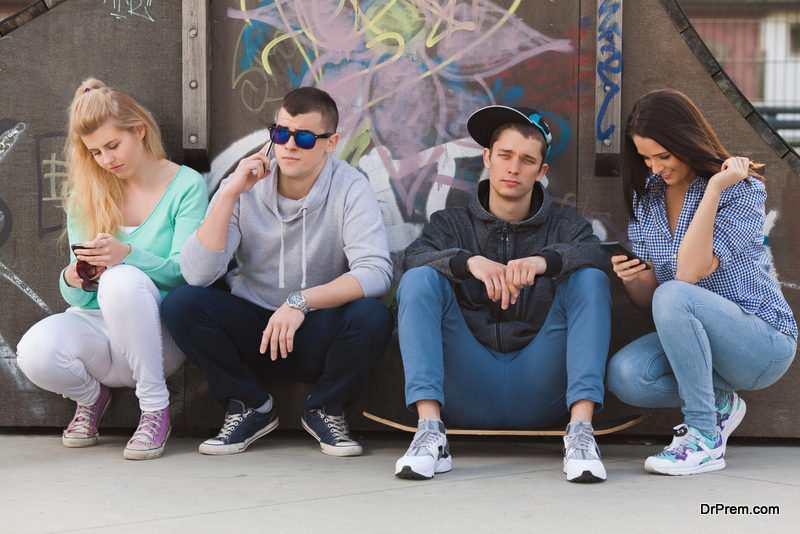It is not surprising to see the present generation teens glued to social media most of their productive time. This crop of people tagged as I-Gen prefers virtual interaction over the internet. For comparison, previous generations not far back in time belonging to same age groups opted for face to face interactions.
With the arrival of smartphones and the internet, they felt off-screen real-time meets less engaging. Smartphone addictions have its obvious consequences. It has triggered loneliness among teens.
Several studies have been conducted by eminent scholars from well-known universities and have come to the same conclusion that screen time and depression are closely connected. Researchers have cautioned about the excessive use of smartphones in exploring social media like Facebook, Snapchat and Instagram that can affect the individual’s wellbeing.
A generation doomed by smartphone usage culminating in loneliness among teens:
 Staying off the screen is important for mental wellbeing, especially the fresh teens who aren’t experienced with the bitter side of life are precariously exposed to evils of social interaction through the net. The feeling of incompetence is catalyzed seeing others doing virtually well on social media platforms. This can lead to social isolation and even suicidal attempts.
Staying off the screen is important for mental wellbeing, especially the fresh teens who aren’t experienced with the bitter side of life are precariously exposed to evils of social interaction through the net. The feeling of incompetence is catalyzed seeing others doing virtually well on social media platforms. This can lead to social isolation and even suicidal attempts.
Studies reveal a radical shift on time spent on smartphones by people born between 1995 and 2012 from the millennials and their slightly senior predecessors. This is true with respect to their perspective of overall life as well. The US and most of the world had suffered an economic downturn from 2007 to 2009.
These kids exposed to this unstable economic vibe have been frantically trying to fit into this unfriendly world where survival is a key factor. Dependence on smartphones outsmarted outdoor games, partying, hanging out with friends and quality time spent at movies. These digital devices have shaped their character and thought process.
This is a global phenomenon irrespective of socio-economic brackets. Having an account on social networking circuits was a trend even before iGens enrolled in high schools. Consequently, these teens were hit most so far as their frail mental strength is concerned. They became more vulnerable to social media evils. Isolation, depression, criminal instigations, suicide and erosion of social fabric with iGens in the foreground could be traced to their smartphones!
Loneliness among teens on the rise:
Spending too much time on the net interacting with friends on social media platforms not only leads to loneliness, it also brings in a feeling of harmed self-esteem. This is called FOMO (fear of missing out).Teens exposed to posts of peers enjoying wealth and luxury vacations make them feel the sting of jealousy in the first place.
Soon jealousy converts into melancholy when the user sees he/she is deprived of all the joys of life that his friends are relishing. This leads to a feeling of rebellion towards parents that they aren’t doing justice. More the teen explores his/her phone, the more intense is the feeling of sorrow.
This sad feeling eventually fuels loneliness among teens. Ironically, friends posting pictures of triumph don’t do the same when it comes to ‘not so happy’ episodes of life. Fresh teens fail to understand the story in full cycle and turn vulnerable to all what leaves them exposed to semi truths. Resultantly, sometimes false posts on social media may give rise to a generation of depressed children. This is highly alarming as it will lead us to get a future generation with unhappy teen years.
Statistics reveal a dramatic surge in smartphone addiction:
 Back in 2011 around 23 % of teens then owned smartphones. The numbers have simply multiplied with around 95% of teens today owning gadgets with more added and sophisticated features. Studies by Dr. Jean Twenge, Professor of Psychology at San Diego State University show, teens today are far less engaged in partying, hanging out with friends and real-time interactions.
Back in 2011 around 23 % of teens then owned smartphones. The numbers have simply multiplied with around 95% of teens today owning gadgets with more added and sophisticated features. Studies by Dr. Jean Twenge, Professor of Psychology at San Diego State University show, teens today are far less engaged in partying, hanging out with friends and real-time interactions.
All they are doing is devoting their whole-hearted attention to smartphones 8-10 hours a day! The study further reveals, in 2016 high school students spent one hour a day less with their peers than their brothers in 1980. If we explore chronologically, more startling facts would come to the surface.
- Towards the end of the1970s, around 52 % of 12th grade students regularly hung around with peers. This number dropped to 28 % in 2017.
- Currently, 10th grade students attend 17 lesser parties than they did in the 1980s. What does this statistic speak about the trend? Cause and effect is plain and visible.
More smartphone use has led to smartphone addiction at the cost of face to face interaction. More exposure to social networking sites leads to a feeling of being out of place owing to lacking achievements in life.
Screen time and depression get intertwined ending in incidents of mounting loneliness among teens. It has a remedy by way of in-person interaction, say experts. Loneliness is threatening, and if unchecked, will create a generation with a history of teenage depression.
Should social interaction over the internet be banned for teens?
Despite ample evidence of social media contributing to the steady rise of loneliness among teens, you cannot write off social apps altogether. It is a matter of concern which should be handled wisely. Forceful deprivation would create other problems. If overindulgence is bad, a complete shut off from the digital social media is not good as well. Teenagers too need to remain updated of certain facts and events which social media provides instantly.
Where an important face to face meet up event among teens is impossible to arrange owing to logistics and location issues, digital social media comes to the rescue. It is the inherent human element in us that is to be blamed more than the media itself. So online social interaction in moderation may not be harmful and will not contribute to loneliness among teens.
Experiments to limit the use of social media and bring down loneliness among teens:
 The University of Pensylvania had conducted an experiment selecting 143 undergraduates at random and restricting their usage of electronic social media platforms. These people aged between 18 to 22 years were asked to use social platforms over a 3-week period under monitored instructions.
The University of Pensylvania had conducted an experiment selecting 143 undergraduates at random and restricting their usage of electronic social media platforms. These people aged between 18 to 22 years were asked to use social platforms over a 3-week period under monitored instructions.
They were allowed to spend 10 minutes each on Facebook, Snapchat and Instagram per day for 3 weeks. Snapshots of battery levels were sent to the monitoring team to get feedback on usage of social media. After the experiment was through, participants reported a reduced feeling of loneliness and depression compared to that before the beginning of the test when they were hooked on i-phones frequently. In particular, for participants with social-media associated depressed state of mind prior to the experiment, there was a marked improvement in their mental wellbeing.
Pros and cons of real and virtual social interaction in the teens’ world:
Neither everything is good nor bad with two forms of interaction. Virtual interaction over the internet lacks vital elements of personal touch, eye contact and emotions that are integral part of human communication since creation. Again, many requirements can be fulfilled through social media via smartphone which may not be possible while interacting in person.
Especially where a group is involved, getting everyone at a place at a point of time has practical shortcomings. It is important today’s teens learn how much time to spend on smartphone and what all inputs to allow inside their minds. Parents and teachers have an important role to play. Balancing interactions online and offline is the key to curb digital smartphone oriented loneliness among teens.



